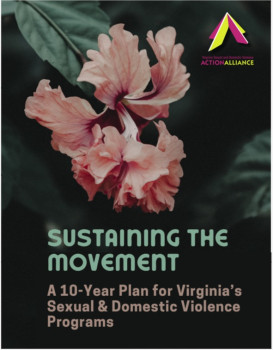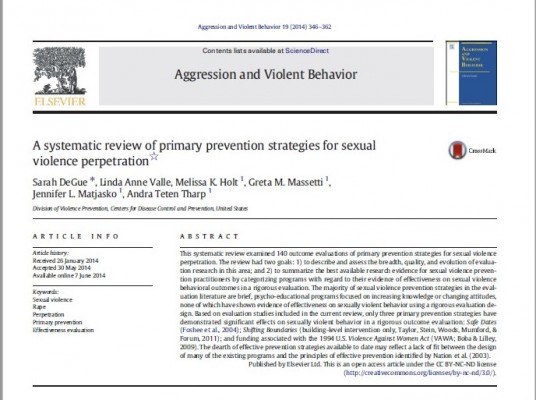Start a Search:
Author: Action Alliance
Supporting Survivors of Abuse with Disabilities
Here are five modules designed for domestic violence and sexual assault service providers to learn how they can enhance their services for people with disabilities. CEU's are available.
These modules were created by the I-CAN! Accessibility Project. The I-CAN! Accessibility Project is a collaboration between the Virginia Commonwealth University School of Social Work and the Partnership for People with Disabilities.
Visit https://sites.google.com/vcu.edu/abusesurvivorswithdisabilities/home to access these resources.
Sustaining the Movement: A 10-Year Plan for Virginia’s Sexual and Domestic Violence Programs

In August 2021, during the second summer of the COVID-19 pandemic, a diverse group of Sexual and Domestic Violence Agency (SDVA) Directors convened to begin discussing the significant and ongoing funding and sustainability challenges faced by Virginia’s 70+ crisis response agencies. The Sustainability Planning Alliance (SPA) was formed, consisting of six Executive Directors and Action Alliance leadership. They met 1-2times a month for the next 18 months. The group represented diverse regions and perspectives across Virginia – including Hampton, Arlington, Fairfax, White Stone, Charlottesville, Harrisonburg, Richmond, and Radford – with public and non-profit organizations represented, dual sexual and domestic violence and single-issue agencies, Black, Brown and White agency leaders, urban, rural, and suburban service areas, and collectively, more than 100 years of direct experience in Virginia’s movement to end sexual and domestic violence. Based on these ongoing discussions and rigorous data gathering, the SPA offers the following 10-Year Movement Sustainability Plan and recommendations to the field.
RECOMENDATIONS FOR THE FIELD
- For Sexual and Domestic Violence Agencies (SDVAs) and Advocates
- - Build a strong diversified financial foundation for the work.
-
- Create robust administrative and operational capacity that supports growth, sustains current programs and staff, and is nimble in the face of programmatic and administrative challenges.
- For Funders and State Partners
- - Build active, reciprocal, and power-sharing partnerships with SDVAs.
-
- Engage with SDVAs to build a strong infrastructure for the field that can access and manage diverse resources and support well-resourced staff.
- For Legislatorsand Policy Leaders
- - Increase state and federal investments in community safety and sexual and domestic violence prevention.
-
- Advocate for the sustainability and growth of Virginia’s local SDVAs.
- For the Virginia State Coalition (Action Alliance)
- - Provide ongoing and robust training, technical assistance, and support to SDVAs to advance local sustainability strategies.
- - Create a unified mission, vision and values for the work of the SV/DV field while supporting agency autonomy, highlighting SDVAs and their value and impact, and providing forums and venues for people in the field to gather and share with people in similar roles and across identities.
This plan is not a mandate, rather it is a set of strategies, grounded in shared values and collective expertise gathered from advocates and directors across Virginia’s movement to end sexual and domestic violence. It is intended to act as a blueprint towards movement sustainability. Our vision is that these recommendations will become a reality and that at the local, state, and federal level, we will move in alignment towards a future in which every sexual and domestic violence agency throughout the Commonwealth is thriving and able to effectively meet the full needs of survivors, families, and their communities.
Download the plan using the link below.
Systematic Review of Primary Prevention Strategies for Sexual Violence Perpetration

This systematic review from 2014 had two goals related to looking at primary prevention strategies for sexual violence: 1) to describe and assess the breadth, quality, and evolution of evaluation
research in this area; and 2) to summarize the best available research evidence for sexual violence prevention practitioners by categorizing programs with regard to their evidence of effectiveness on sexual violence behavioral outcomes in a rigorous evaluation.
The study found 3 strategies that had significant effects on sexually violent behavior in a rigorous outcome evaluation: Safe Dates (Foshee et al., 2004); Shifting Boundaries (building-level intervention only, Taylor, Stein, Woods, Mumford, & Forum, 2011); and funding associated with the 1994 U.S. Violence Against Women Act (VAWA; Boba & Lilley, 2009).
Tactics of Oppression

Power and control look alike whether perpetrated against an intimate partner or an entire cultural/ethnic group.
Whether we are talking about power and control within an intimate relationship, or within the whole of U.S. society, we see the same tactics used to maintain an unequal distribution of power, control and access to resources.
This handout outlines examples of oppressive tactics used to control individuals in the context of intimate relationships compared with similar tactics used by government entities to control entire ethnic or cultural groups and communities.
Attribution: Content developed by Nathaniel Shara for 2012 Northwest Network Q&A for Advocates Training, Seattle WA - nathan@nwnetwork,org. Used with permission.
Tech Abuse: Information from the Field Survey Findings from the Conference on Crimes Against Women
NNEDV surveyed over 300 conference attendees on what types of technology misuse survivors are reporting, the number of cases their agency sees of technology misuse, and their agency’s ability to respond to survivor’s technology concerns. This report shows their findings.

